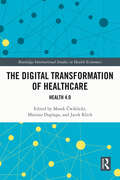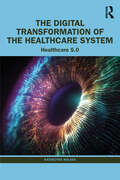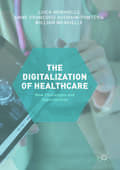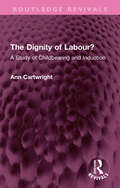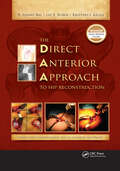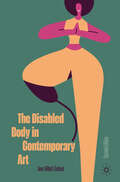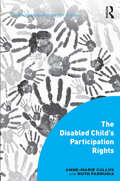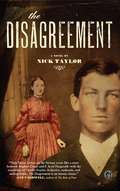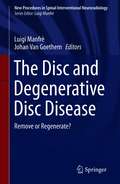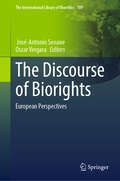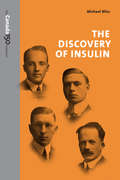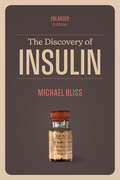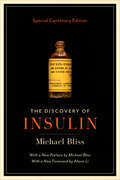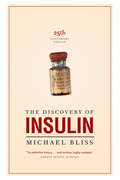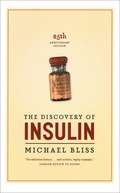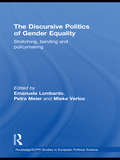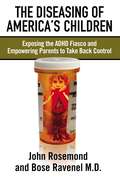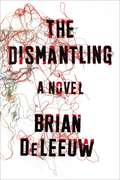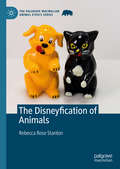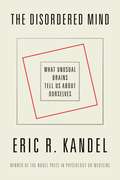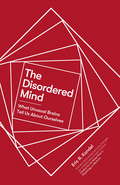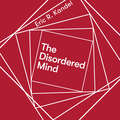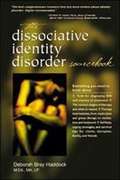- Table View
- List View
The Digital Transformation of Healthcare: Health 4.0 (Routledge International Studies in Health Economics)
by Mariusz Duplaga Jacek Klich Marek ĆwiklickiHealth 4.0 is a term that has derived from the Fourth Industrial Revolution (Industry 4.0), as it pertains to the healthcare industry. This book offers a novel, concise, but at the same time, broad picture of the challenges that the technological revolution has created for the healthcare system. It offers a comprehensive view of health sector actors’ interaction with the emerging new technology, which is disrupting the status quo in health service delivery. It explains how these technological developments impact both society and healthcare governance. Further, the book addresses issues related to key healthcare system stakeholders: the state, patients, medical professionals, and non-governmental organizations. It also examines areas of healthcare system adaptiveness and draws its conclusions by analysing recent health policy changes in different countries across the Americas, Europe, and Asia. The authors offer an innovative approach to the subject by identifying the critical determinants of successful implementation of the Fourth Industrial Revolution’s outcomes in practice, on both a macro- and microlevel. The macrolevel analysis is focused on essential factors of healthcare system adaptiveness for Health 4.0, while the microlevel relates to patients’ expectations with a particular emphasis on senior citizens. The book will appeal to academics, researchers, and students, across a wide range of disciplines, such as health economics, health sciences, public policy, public administration, political science, public governance, and sociology. It will also find an audience among healthcare professionals and health and social policymakers due to its recommendations for implementing Industry 4.0 into a healthcare system.
The Digital Transformation of the Healthcare System: Healthcare 5.0
by Katarzyna KolasaThis book examines how the digital revolution has reorganized the model of healthcare during the COVID-19 pandemic and argues for a continued paradigm shift to digital healthcare. Katarzyna Kolasa sets the vision of healthcare 5.0 that relieves the burden on limited healthcare resources and creates better health outcomes by switching the focus from treatment to prediction and prevention. She advocates for a patient-centric ecosystem that empowers patients to take control of their health via new knowledge-based technologies such as next-generation sequencing (NGS), nanotechnology, artificial intelligence and digital therapeutics. Highlighting the mindset shift needed to transform healthcare and outlining in detail a futuristic vision of healthcare 5.0, this book will be of interest to academics and professionals of health policy, health economics and digital health.
The Digitization of Healthcare
by Loick Menvielle Anne-Françoise Audrain-Pontevia William MenvielleCombining conceptual, pragmatic and operational approaches, this edited collection addresses the demand for knowledge and understanding of IT in the healthcare sector. With new technology outbreaks, our vision of healthcare has been drastically changed, switching from a 'traditional' path to a digitalized one. Providing an overview of the role of IT in the healthcare sector, The Digitization of Healthcare illustrates the potential benefits and challenges for all those involved in delivering care to the patient. The incursion of IT has disrupted the value chain and changed business models for companies working in the health sector, and also raised ethical issues and new paradigms about delivering care. This book illustrates the rise of patient empowerment through the development of patient communities such as PatientLikeMe, and medical collaborate platforms such as DockCheck, thus providing a necessary tool to patients, caregivers and academics alike.
The Dignity of Labour?: A Study of Childbearing and Induction (Routledge Revivals)
by Ann CartwrightOriginally published in 1979, this study looks at the experience of childbearing from three viewpoints: first and foremost from that of the childbearing women; but in addition it considers the views and experiences of midwives and consultant obstetricians.It examines the proportion of induced labours and questions who is induced, when, where and why and how. Comparisons are then made between induced and non-induced labours of mothers’ experiences of labour and delivery and then of the babies conditions and the early relationships between the mothers and babies. Women’s views of their experiences, their attitudes to the information they were given, and their choice for treatment at further pregnancies are then examined.In the final chapter induction policies and practices are reviewed in the light of women’s reactions to their experiences. The implications of the findings are discussed in relation to other innovatory and interventionist procedures and in the context of the women’s movement.
The Direct Anterior Approach to Hip Reconstruction
by B. Bal Lee Rubin Kristaps KeggiTotal hip arthroplasty has steadily evolved to improve patient outcomes and safety. One innovation has been to incorporate less invasive surgical methods, such as the direct anterior surgical approach. The Direct Anterior Approach to Hip Reconstruction is a comprehensive reference text that addresses contemporary surgeon interest in innovation and less invasive surgery. This resource will help with introductory learning, intermediate technical development, and advanced revision total hip skills using the direct anterior technique. Accordingly, the text is structured into three sections as follows: Basic concepts: Surgical hip anatomy, patient selection, and placement of single, multiple, and extensile incisions for primary total hip arthroplasty Intermediate concepts: Adoption of imaging and navigation technologies, use of traction tables to enhance positioning, and presentation of unique instruments and custom devices that have evolved specifically for the direct anterior approach Advanced concepts: Using the direct anterior approach for bearing and liner exchanges, acetabular revisions, femoral component revisions, and both component revisions. Drs. B. Sonny Bal, Lee E. Rubin, and Kristaps J. Keggi have combined their unique perspectives, along with those of a renowned group of North American and European experts in the anterior hip reconstruction surgery to create this reference. Dr. Keggi was among the first to recognize the benefits of the direct anterior approach in hip reconstruction; this text is based on his 50-plus years of experience as a clinician and pioneer surgeon. The Direct Anterior Approach to Hip Reconstruction provides a stepwise learning process for surgeons interested in mastering total hip arthroplasty using the direct anterior approach, with detailed chapters and video instruction, contributed by a distinguished group of international experts in the field.The chapters focus on using the direct anterior approach to address a variety of hip problems well beyond performing total hip arthroplasty for osteoarthritis. The unique applications of the direct anterior approach within the orthopedic sub-specialties are addressed in chapters covering the fields of pediatrics, sports medicine, trauma, and tumor surgery. Other chapters address subjects like femoroacetabular impingement, hip preservation surgery, and postoperative rehabilitation protocols designed to improve patient outcomes.The final section of the text reviews the evidence-based outcomes related to direct anterior total hip arthroplasty, addressing evolving implant design concepts specific to this approach, and outlining directions for educating the next generation of surgeons who will continue to develop and refine these techniques. Complementing the written text is a website with educational videos to further enhance the learning experience.To date, no other reference has addressed the need for comprehensive education for the orthopedic resident, fellow, or surgeon seeking to learn about the direct anterior approach for hip reconstruction. This resource should be invaluable to orthopedic surgeons worldwide and will contribute to improving patient safety, reducing complications, and better surgical outcomes. Indeed, this landmark publication is truly the world’s first comprehensive text on anterior hip surgery.
The Disabled Body in Contemporary Art
by Ann Millett-GallantThe second edition offers an essential update to the foundational first edition, The Disabled Body in Contemporary Art. Featuring updated chapters and case studies, this second edition will not only expand on the first edition but will bring a new focus to contemporary disabled artists and their embodied, multimedia work.
The Disabled Child's Participation Rights (Interdisciplinary Disability Studies)
by Anne-Marie Callus Ruth FarrugiaThe United Nations Convention on the Rights of Persons with Disabilities is the only UN treaty to date in which the people who are its target, that is disabled people, were actively involved in its drafting and the only one which requires the active participation of disabled people in its implementation. This does not, of course, automatically guarantee the direct participation of all disabled people. This is especially so for children with disabilities, whose status as legal minors may inhibit them from participating in decisions affecting their lives. This book focuses on the participation rights of the disabled child with regard to health, education, homelife and relationships, highlighting ways in which these rights are safeguarded and promoted throughout the EU, as well as exploring the factors that put these rights at risk. Finally, this groundbreaking text analyses whether disabled children’s needs for assistance in order to realise their participation rights results in fewer opportunities to participate or in an increase in support in order for them to be able to do so.
The Disabled Woman's Guide to Pregnancy and Birth
by Judith RogersThe Disabled Woman's Guide to Pregnancy and Birth is a comprehensive and useful guide that is based on the experiences of women with disabilities who chose to have children. Thoroughly researched and informative, this book is a practical guide for both disabled women planning for pregnancy, and the health professionals who work with them.
The Disagreement
by Nick TaylorIt is April 17, 1861 -- the day that Virginia secedes from the Union and the sixteenth birthday of John Alan Muro. As the Commonwealth erupts in celebration, young Muro sees his dream of attending medical school in Philadelphia shattered by the sudden reality of war. Muro's father, believing that the Disagreement will pass, sends his son instead to Charlottesville. Jefferson's forty-year-old University of Virginia has become a haven of rogues and dilettantes, among them Muro's roommate, Braxton Baucom III, a planter's son who attempts to strike a resemblance to General "Stonewall" Jackson. Though the pair toasts lightheartedly "To our studies!" with a local corn whiskey known as "The Bumbler," the war effort soon exerts a sobering influence. Medical students like Muro are pressed into service at the Charlottesville General Hospital, where the inexperienced Dr. Muro saves the life of a Northern lieutenant, earning the scorn of his peers. As the war progresses, Muro takes up yet another cause -- winning the affections of the beguiling Miss Lorrie Wigfall. Here, too, Muro faces a cunning adversary. Just as the fighting is closing in, Muro is forced to make a choice that will shape the rest of his life. In this story of love, loyalty, and unimaginable sacrifice, a doctor struggles to balance the passions of youth with the weight of responsibility.
The Disc and Degenerative Disc Disease: Remove or Regenerate? (New Procedures in Spinal Interventional Neuroradiology)
by Luigi Manfrè Johan Van GoethemThis easy-to-consult guide examines the most advanced techniques in the radiological evaluation of the disc and degenerative disc disease, using conventional, functional, dynamic and advanced imaging. It provides clear information on a range of CT, X-ray, and MRI guided techniques, presents all disc treatments in connection with symptomatic disc herniations, evaluates conservative, chemical (ESI, steroid, Ozone, ethanol gel injections) and physical treatments (coblation, laser, decompressors, endoscopy), and assesses the possibility of repairing and/or regenerating the disc in the context of reversible disc degeneration. Like other books in the Springer series New Procedures in Spinal Interventional Neuroradiology, this practice-oriented volume will fill a significant gap in the literature and meet the need expressed by many specialists (interventional neuroradiologists and radiologists, neurosurgeons, and orthopedists) for a topical and handy guide that specifically illustrates the currently available materials and methods.
The Discourse of Biorights: European Perspectives (The International Library of Bioethics #109)
by José-Antonio Seoane Oscar VergaraThis book provides answers to the questions that biomedical and biotechnological research has posed to our societies by proposing the introduction of biorights. It shows how bioscience affects our individual and social lives by discussing and answering important questions such as; Are we becoming more vulnerable and unable to protect ourselves? How can we ensure fairness and justice with regards to the access to health care? Are human dignity, autonomy and equality at risk? Do we need new and special rights: neurorights, genetic rights? What is the meaning and scope of the right to life, health, privacy or non-discrimination? Biorights are the suggested solution for dealing with these challenges. Healthcare professionals, bio-researchers, policy makers, scholars, and citizens will, in this book, find a guide to knowing how bioscience affects our lives. Furthermore, this book provides a comprehensive method for biomedical and biotechnological decision-making that comprises human or basic rights dimensions alongside technical and ethical dimensions. Chapters 1, 12 and 18 are available open access under a Creative Commons Attribution 4.0 International License via link.springer.com.
The Discovery of Insulin
by Michael BlissWhen insulin was discovered in the early 1920s, even jaded professionals marveled at how it brought starved, sometimes comatose diabetics back to life. In the twenty-fifth-anniversary edition of a classic, Michael Bliss unearths scientists' memoirs and confidential appraisals of insulin by members of the Nobel Committee. He also resolves a longstanding controversy about scientific collaboration at its most fractious and fascinating: who ultimately deserves credit for the discovery? Bliss's life-and-death saga illuminates one of the most important break throughs in the history of medicine. Book jacket.
The Discovery of Insulin
by Michael BlissThe discovery of insulin at the University of Toronto in 1921-22 was one of the most dramatic events in the history of the treatment of disease. Insulin was a wonder-drug with ability to bring patients back from the very brink of death, and it was no surprise that in 1923 the Nobel Prize for Medicine was awarded to its discoverers, the Canadian research team of Banting, Best, Collip, and Macleod. In this engaging and award-winning account, historian Michael Bliss recounts the fascinating story behind the discovery of insulin – a story as much filled with fiery confrontation and intense competition as medical dedication and scientific genius. Originally published in 1982 and updated in 1996, The Discovery of Insulin has won the City of Toronto Book Award, the Jason Hannah Medal of the Royal Society of Canada, and the William H. Welch Medal of the American Association for the History of Medicine.
The Discovery of Insulin: Enlarged Edition
by Michael BlissThis edition of a landmark work of scholarship includes both a new preface by the author and a new foreword that places the book in its historical context. When insulin was discovered in the early 1920s, even jaded professionals marveled at how it brought starved, sometimes comatose patients with diabetes back to life. Defying the average timeline, the 1923 Nobel Prize in Physiology or Medicine was awarded for its discovery. To recount the fascinating story behind the discovery of insulin, in this classic work Michael Bliss draws on archival records and personal interviews with witnesses to the events. He unearths scientists’ memoirs and confidential appraisals of insulin by members of the Nobel Committee, bringing science to life and resolving a longstanding controversy about scientific collaboration at its most fractious and fascinating: who among the Canadian team of Frederick Banting, Charles Best, James Collip, and John Macleod ultimately deserves credit for the discovery of insulin? Or is credit due farther afield—to Georg Zuelzer in Berlin, E.L. Scott in Chicago, Israel Kleiner in New York, Nicolas Paulescu in Bucharest, John Murlin in Rochester? Bliss’s life-and-death saga illuminates one of the most important breakthroughs in the history of medicine. With a new preface by the author and a foreword by historian Alison Li, this enlarged edition celebrates the lasting impact of insulin’s discovery and ongoing importance.
The Discovery of Insulin: Special Centenary Edition
by Michael BlissThe discovery of insulin at the University of Toronto in 1921–2 was one of the most dramatic events in the history of the treatment of disease. Insulin, discovered by the Canadian research team of Frederick Banting, Charles Best, James Collip, and John Macleod, was a wonder drug with the ability to bring diabetes patients back from the brink of death. It was no surprise that in 1923 the Nobel Prize for Medicine was awarded for its discovery. In this engaging and award-winning account, historian Michael Bliss draws on archival records and personal adventures to recount the fascinating story behind the discovery of insulin – a story as much filled with fiery confrontation and intense competition as medical dedication and scientific genius. With a new preface by Michael Bliss and a foreword by Alison Li, the special centenary edition of The Discovery of Insulin honours the one hundredth anniversary of insulin’s discovery and its continued significance a century later.
The Discovery of Insulin: The Twenty-fifth Anniversary Edition
by Michael BlissThe discovery of insulin at the University of Toronto in 1921-22 was one of the most dramatic events in the history of the treatment of disease. Insulin was a wonder-drug with ability to bring patients back from the very brink of death, and it was no surprise that in 1923 the Nobel Prize for Medicine was awarded to its discoverers, the Canadian research team of Banting, Best, Collip, and Macleod. In this engaging and award-winning account, historian Michael Bliss recounts the fascinating story behind the discovery of insulin – a story as much filled with fiery confrontation and intense competition as medical dedication and scientific genius. Originally published in 1982 and updated in 1996, The Discovery of Insulin has won the City of Toronto Book Award, the Jason Hannah Medal of the Royal Society of Canada, and the William H. Welch Medal of the American Association for the History of Medicine.
The Discovery of Insulin: Twenty-fifth Anniversary Edition
by Michael Bliss“The new edition of this historical masterpiece . . . fleshes out events and personalities through a narrative that remains as stirring and relevant as ever.” —Robert A. Hegele, Western UniversityWhen insulin was discovered in the early 1920s, even jaded professionals marveled at how it brought starved, sometimes comatose diabetics back to life. In the twenty-fifth anniversary edition of a classic, Michael Bliss unearths scientists’ memoirs and confidential appraisals of insulin by members of the Nobel Committee. He also resolves a longstanding controversy about scientific collaboration at its most fractious and fascinating: who ultimately deserves credit for the discovery? Bliss’s life-and-death saga illuminates one of the most important breakthroughs in the history of medicine.“The Discovery of Insulin deserves a place on the bookshelf alongside such eye-openers as James Watson’s The Double Helix.” —Washington Post“The definitive history . . . well written, highly readable.” —London Review of Books“Scrupulously researched and compellingly readable . . . I wholeheartedly recommend it to anyone with an interest in diabetes, medical history, or medical scandal and gossip.” —British Medical Journal“This book reaches well beyond the story of insulin. It is a timeless chronicle on the pursuit of science, as well as the nature of discoveries and the people who make them.” —Jeffrey M. Friedman, Marilyn M. Simpson Professor, The Rockefeller University, and Investigator, Howard Hughes Medical Institute
The Discursive Politics of Gender Equality: Stretching, Bending and Policy-Making (Routledge/ECPR Studies in European Political Science)
by Emanuela Lombardo Mieke Verloo Petra MeierThis book explores the discursive constructions of gender equality and the implications of these understandings in a broad range of policy fields. Using gender equality as a prime example, a number of internationally renowned scholars offer a new vocabulary to identify and study processes of the reduction, amplification, shifting or freezing of meaning. The main aim of the book is to understand the dynamics and to reflect on the consequences of such discursive politics in recent policy making on gender equality. It explores both the potential opportunities that are opened up for the promotion of equality through discursive politics, and the limitations they impose. Distinctive features of the volume include: chapters covering a range of case studies in Europe, the USA, and the Asia region, tackling contemporary political debates on equality new insights of relevance to public policy practices such as gender mainstreaming, with theorizing on intersecting inequalities The Discursive Politics of Gender Equality will be of interest to students and scholars, of political science, public policy, comparative politics, gender and women studies.
The Diseasing of America's Children: Exposing the ADHD Fiasco and Empowering Parents to Take Back Control
by John Rosemond Bose RavenelHow parents, teachers, and even professionals are being deceived by the "ADHD Establishment" regarding ADHD and other childhood behavior disorders and the drugs used to treat them. The issue of diagnosing children with behavioral diseases that do not conform to a scientific definition of disease, and then medicating them is a scandal ready to erupt. In The Diseasing of America's Children, popular family psychologist, speaker and best-selling author John Rosemond joins with pediatrician Dr. Bose Ravenel to uncover the fiction and fallacy behind attention-deficit/hyperactivity disorder (ADHD), oppositional defiant disorder (ODD), early-onset biopolar disorder (EOBD), and the drugs prescribed to treat them. Rosemond and Ravenel will: reveal the pseudo-science behind these diagnoses; explain how parents, teachers, and even professionals are deceived; expose the short- and long-term dangers behavioral drugs pose to children; discuss how America's schools are unwittingly feeding the diagnostic beast; reveal the simple, common sense truth behind these behavior problems and give parents a practical program for curing these problems without drugs or dependence on professionals.
The Dismantling
by Brian DeleeuwHow much of yourself are you willing to sell?Brian DeLeeuw hits that sweet spot between literary and commercial suspense with his brilliantly adept, ingeniously plotted novel--a chilling, fast-paced drama that urges readers to question the meaning of atonement and whether revenge might sometimes be the only way we can liberate ourselves from our past.Twenty-five-year-old med school dropout Simon Worth is an organ broker, buying kidneys and livers from cash-strapped donors and selling them to recipients whose time on the waitlist is running out. When a seemingly straightforward liver transplant has an unexpectedly dangerous outcome, Simon finds himself on the run. In order to survive, he must put aside his better moral judgment and place his trust in a stranger who has a shocking secret.From the Trade Paperback edition.
The Disneyfication of Animals (The Palgrave Macmillan Animal Ethics Series)
by Rebecca Rose StantonThis book critically examines how Walt Disney Animation Studios has depicted – and sometimes failed to depict – different forms of harming and objectifying non-human animals in their films. Each chapter addresses a different form of animal harm and objectification through the theories of speciesism, romanticism, and the ‘collapse of compassion’ effect, from farming, hunting and fishing, to clothing, work, and entertainment. Stanton lucidly presents the dichotomy between depictions of higher order, anthropomorphised and neotonised animal characters and that of lower-order species, showing furthermore how these depictions are closely linked to changing social attitudes about acceptable forms of animal harm. An engaging and novel contribution to the field of Critical Animal Studies, this book explores the use of animals not only in Disney’s best known animated films such as 101 Dalmatians, but also lesser known features including Home on the Range and Fun and Fancy Free. A quantitative appendix supplying data on how often each animal species appears and the amount of times animal harm or objectification is depicted in over fifty films provides an invaluable resource and addition to scholars working in both Disney and animal studies.
The Disordered Mind: What Unusual Brains Tell Us About Ourselves
by Eric R. KandelEric R. Kandel, the winner of the Nobel Prize in Physiology or Medicine for his foundational research into memory storage in the brain, is one of the pioneers of modern brain science. His work continues to shape our understanding of how learning and memory work and to break down age-old barriers between the sciences and the arts.In his seminal new book, The Disordered Mind, Kandel draws on a lifetime of pathbreaking research and the work of many other leading neuroscientists to take us on an unusual tour of the brain. He confronts one of the most difficult questions we face: How does our mind, our individual sense of self, emerge from the physical matter of the brain? The brain’s 86 billion neurons communicate with one another through very precise connections. But sometimes those connections are disrupted. The brain processes that give rise to our mind can become disordered, resulting in diseases such as autism, depression, schizophrenia, Parkinson’s, addiction, and post-traumatic stress disorder. While these disruptions bring great suffering, they can also reveal the mysteries of how the brain produces our most fundamental experiences and capabilities—the very nature of what it means to be human. Studies of autism illuminate the neurological foundations of our social instincts; research into depression offers important insights on emotions and the integrity of the self; and paradigm-shifting work on addiction has led to a new understanding of the relationship between pleasure and willpower.By studying disruptions to typical brain functioning and exploring their potential treatments, we will deepen our understanding of thought, feeling, behavior, memory, and creativity. Only then can we grapple with the big question of how billions of neurons generate consciousness itself.
The Disordered Mind: What Unusual Brains Tell Us About Ourselves
by Eric R. KandelNeurological and psychiatric disorders have long been regarded as fundamentally different, depending on whether they appear to affect the brain or the mind. In reality, the brain and the mind are inseparable. Both types of disorder can affect every aspect of brain function: from perception, action, memory and emotion to empathy, social interaction, attention and consciousness. It is easy to view brain disorders as simply tragic or frightening. However, studying where these functions go wrong provides a window on the workings of the healthy brain, and makes it more likely that scientists and clinicians will be able to develop effective treatments or preventative strategies. As individuals, and as a society, we are also able to better empathise with people with disorders of the mind.Building on his pioneering research, Eric R. Kandel illustrates how breakthrough studies of brain disruptions can deepen our understanding of thought, feeling, behaviour, memory and creativity, and perhaps in the future will transform medical care and lead to the development of a unified theory of mind.
The Disordered Mind: What Unusual Brains Tell Us About Ourselves
by Eric R. Kandel'[Kandel's discoveries] have truly changed our understanding of brain function' - Citation for the Nobel Prize in Physiology or Medicine'[Eric Kandel is] one of the preeminent neuroscientists in the world' - Sue Halpern, The New York Review of Books Highly commended at the British Medical Association Book Awards 2019Neurological and psychiatric disorders have long been regarded as fundamentally different, depending on whether they appear to affect the brain or the mind. In reality, the brain and the mind are inseparable. Both types of disorder can affect every aspect of brain function: from perception, action, memory and emotion to empathy, social interaction, attention and consciousness. It is easy to view brain disorders as simply tragic or frightening. However, studying where these functions go wrong provides a window on the workings of the healthy brain, and makes it more likely that scientists and clinicians will be able to develop effective treatments or preventative strategies. As individuals, and as a society, we are also able to better empathise with people with disorders of the mind.Building on his pioneering research, Eric R. Kandel illustrates how breakthrough studies of brain disruptions can deepen our understanding of thought, feeling, behaviour, memory and creativity, and perhaps in the future will transform medical care and lead to the development of a unified theory of mind.
The Dissociative Identity Disorder Sourcebook (Sourcebooks)
by Deborah HaddockFrom Eve to Sybil to Truddi Chase, the media have long chronicled the lives of people with dissociative identity disorder (DID), formerly known as multiple personality disorder. The Dissociative Identity Disorder Sourcebook serves as a much-needed bridge for communication between the dissociative individual and therapists, family, and friends who also have to learn to deal with the effects of this truly astonishing disorder.
